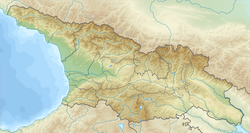This article needs additional citations for verification .(September 2009) |
 | |||||||||||||||
| Alternative names | Abastumani Astrophysical Observatory | ||||||||||||||
|---|---|---|---|---|---|---|---|---|---|---|---|---|---|---|---|
| Observatory code | 119 | ||||||||||||||
| Location | Abastumani, Adigeni Municipality, Samtskhe–Javakheti, Georgia | ||||||||||||||
| Coordinates | 41°45′15″N42°49′10″E / 41.7542°N 42.8194°E | ||||||||||||||
| Altitude | 1,650 m (5,410 ft) | ||||||||||||||
| Website | observatory | ||||||||||||||
| Telescopes | |||||||||||||||
| |||||||||||||||
| | |||||||||||||||
Georgian National Astrophysical Observatory (GENAO) was founded in 1932 by Academician Evgeni Kharadze on Mount Kanobili, near the Abastumani resort in the Samtskhe-Javakheti region of southeastern Georgia. The altitude of Mt. Kanobili varies between 1650 and 1700 m above sea level. The observatory is located ~250 km from Tbilisi, the capital of Georgia. Its distance from air pollution and artificial sky illumination, together with excellent natural conditions (a hilly landscape covered with coniferous forest) make this location one of the best for observatories at the same altitude range. The weather is stable, without harsh and sudden changes.
Contents
The observatory carries out wide-profile research spanning different fields of astronomy and astrophysics and investigations of the upper layers of Earth's atmosphere.

